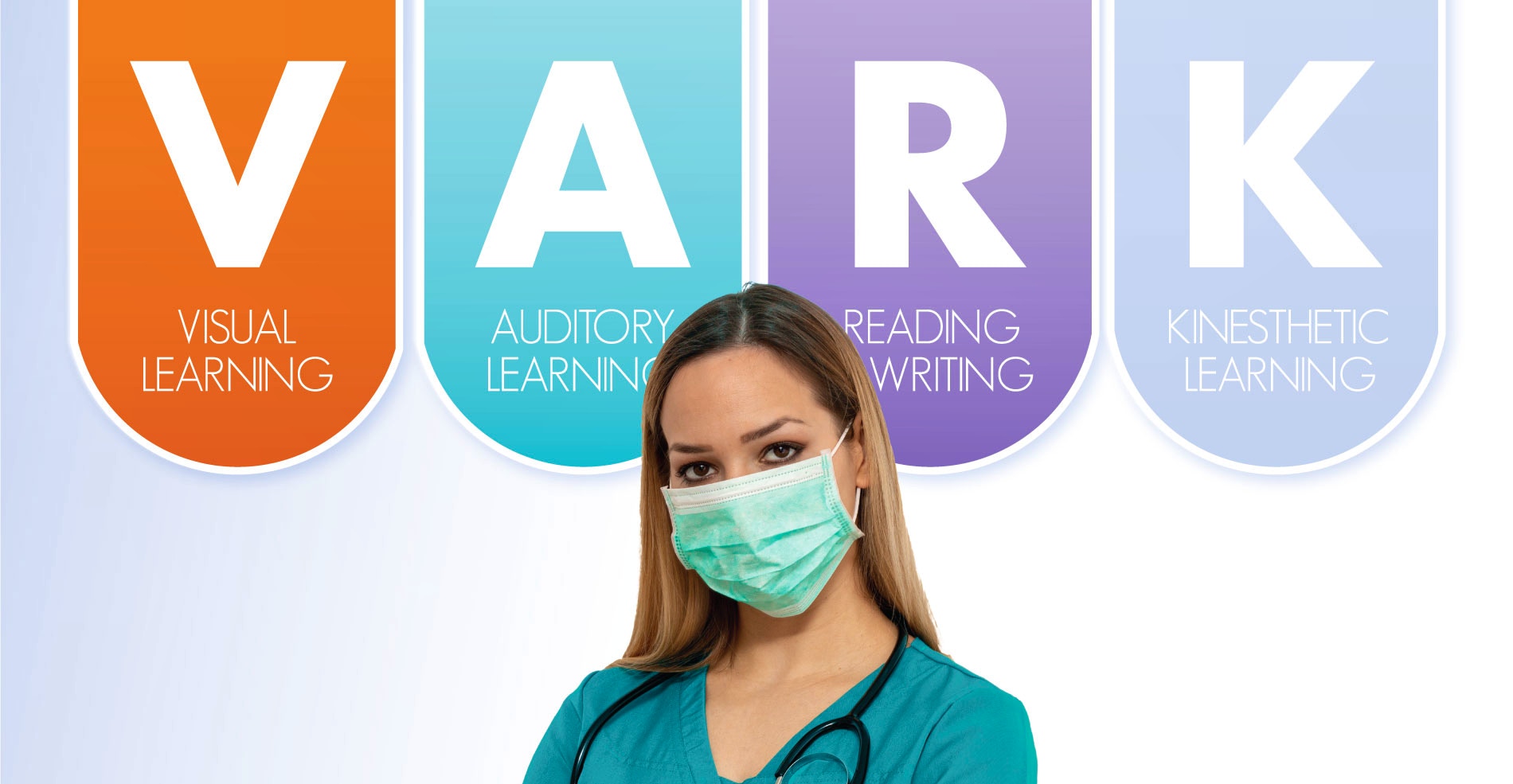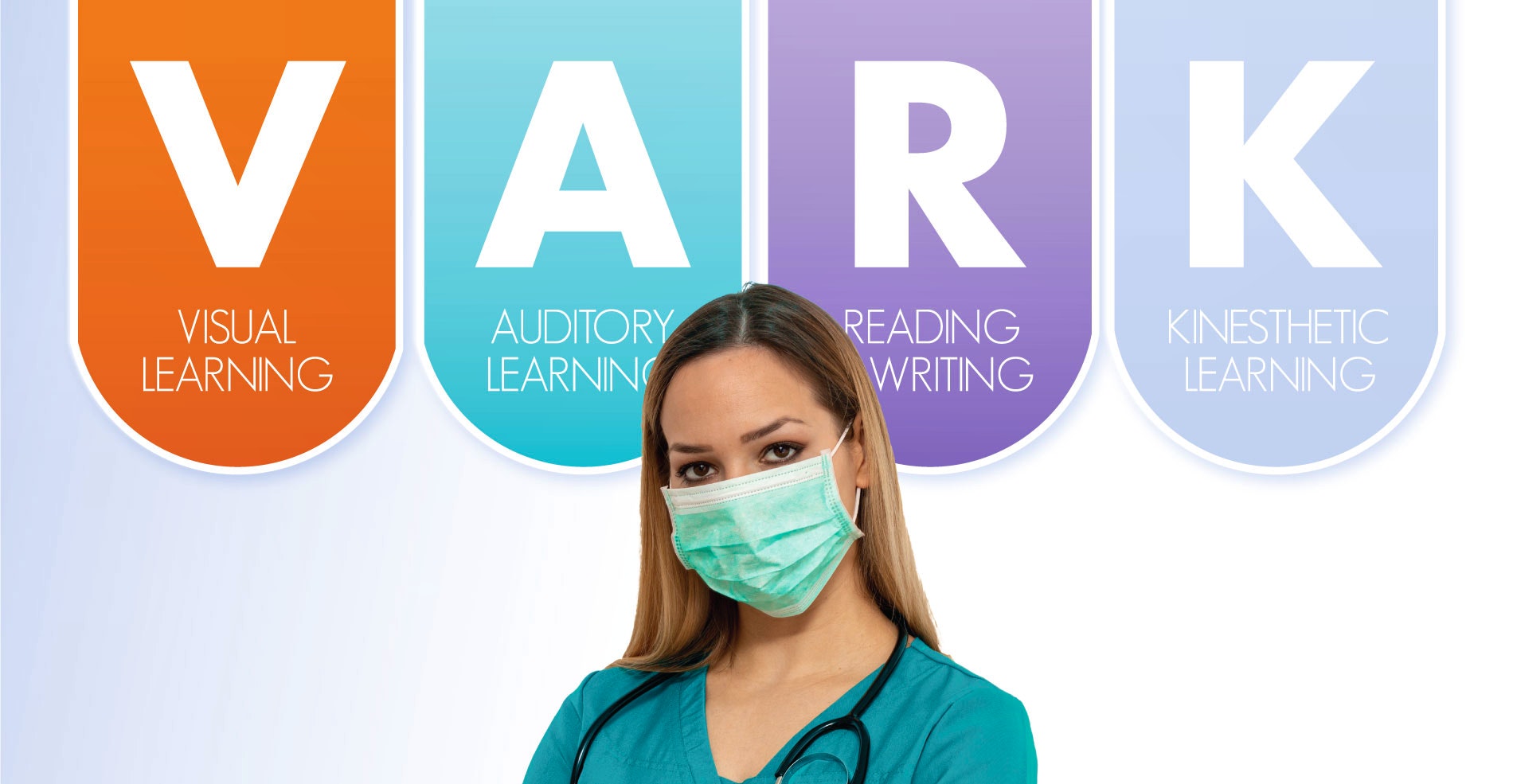The Best Nursing School Tips for Every Learning Preference
October 1



Learning styles are commonly referenced ways to improve students’ performance in school — but they might not work like you think they do.
Education theorist Neil Fleming proposed the popular “VARK” model in 1987, hypothesizing that students learn better when they receive content in a manner that matches their dominant learning style.
VARK stands for Visual, Auditory, Reading and Kinesthetic, which Fleming presented as the four main learning styles.
Though it’s true that every student has different learning preferences, there is no scientific evidence supporting the hypothesis that students learn better when they receive information in only one learning style, according to the Poorvu Center for Teaching and Learning at Yale University.
Instead, the VARK model has transformed into a reminder that students retain information best when using several different learning tactics. Students who prefer visual materials may learn best by pairing visual and kinesthetic tactics to reinforce learning.
Teachers and psychologists agree that the more different ways you expose yourself to a topic, the quicker you will learn it.
This finding couldn’t be more accurate for nursing students, who must learn large swaths of information on a daily basis to be successful.
Nursing students should take inspiration from the VARK model by using study strategies for every learning preference.
Visual
Of the four VARK categories, visual learning might most closely match the methods your teachers already use in nursing school. Diagrams, images, animations, simulations and other visual aids are critical to understanding how a nursing concept applies in practice.
Research shows that 75% of the information the brain processes is in a visual format. When nursing students can associate concepts with images in their minds, they may be able to retain the information better.
Nursing curriculums contain complicated concepts and processes that may benefit from additional visual explanations. Add some of these visually-enhancing strategies to your daily studies. __
- Sit at the front of the lecture hall.__
Don’t be afraid to be that nursing student at the front of your classroom or lecture hall.
Studies suggest that sitting further away from your teacher negatively impacts students’ grades. Researchers can partly attribute this association to the fact that students in the front may have more motivation.
However, the front row is also beneficial because it provides a clear, unobstructed view of anything your teacher presents, from notes and diagrams on the chalkboard to PowerPoint slides on the big screen.
2. Transform your notes into works of art.
Take detailed notes, complete with color-coded headers and copied-down diagrams. Consider using different colors for each condition, medication or process, so your notes are easy to skim. Add a star or other doodle beside topics you know you will see on upcoming quizzes or exams.
When you need to review a concept, try mind mapping, a proven technique that combines words with pictures in a sprawling, interconnected diagram. Start by drawing a term in the center of the page, then draw an arrow and separate bubbles for every piece of material you need to remember about that term.
3. Use flashcards to learn the material.
Flashcards are a tried-and-true way for nursing students to quiz themselves on terms and conditions.
Rather than making a card for every term, focus on using flashcards for must-know core content that will follow you throughout school and on the NCLEX®, such as the essentials of Acid-Base Balance.
Beef up your study time by making additional flashcards for diagrams or images you will need to be able to label and know well.
4. Stock up on sticky notes.
Give yourself visual reminders of your school tasks, such as with planners, calendars or sticky notes. When reading a textbook, use highlighters to draw attention to important passages and take notes in the margins. If you can’t mark up your book, consider buying a pack of sticky notes to capture your thoughts in context.
Some nursing students may additionally benefit from using a planner to keep track of upcoming deadlines and exam dates. For people who enjoy doodling, consider making your own bullet journal-style planner.
Auditory
Nursing students receive and process auditory information daily through videos, lectures, podcasts, presentations and discussions.
Though studies have found that our auditory memory is not as robust as our visual memory, pairing auditory and visual strategies together can help nursing students understand the material better and retain information longer.
In addition to the auditory strategies already used in your nursing classes, leverage one of these tips the next time you study for a big test.
1. Study with a partner or group.
Studying with other nursing students lets you hear how different people understand complex concepts. Listening to explanations repeatedly ensures the materials stay with you long after you finish your test.
Not only can study partners fill in gaps in your learning, but they also can make studying more fun. Nursing school can be lonely, so being around people for those late-night study sessions can strengthen feelings of belonging.
Keep study groups to three or four other students to ensure that everyone has plenty of opportunities to ask and answer questions.
2. Play lyric-free music while you work.
For decades, researchers have explored the link between music and learning, suggesting that listening to classical music, ambient noise or even nature sounds can boost memory, mood and productivity.
A classic study in “Nature” found that listening to Mozart can improve short-term spatial-temporal reasoning. Another study implies that a moderate level of ambient noise can improve creativity.
Try working on a patio to soak up the sounds of the street while you study, or play lyric-free music through noise-canceling headphones to increase your concentration.
3. Record yourself and your instructors.
Recording and re-listening to lectures can help you capture insights from your instructors that you might have missed.
Similarly, recording yourself explaining a concept allows you to hear where you soared and where you stumbled. Keep presenting the material aloud to a mock audience until you’re confident.
If you’re not comfortable recording yourself, teach the concept to a friend or family member who can serve as a live, captive audience.
4. Make up tunes or jingles.
Do lyrics from a song on the radio or jingles from television commercials get stuck in your head? That’s because rhythm and repetition can be an effective way to send material into your long-term memory storage.
As you study, get your creative juices flowing by turning pieces of information into catchy raps or rhymes. On the day of a test, your new tune might make it easier to recall the details of each nursing concept.
Reading
This learning preference revolves around reading and writing, two of the most common practices in nursing school.
Reading and writing can expand your vocabulary, knowledge base and worldview, as well as expose you to ground-breaking new research and theories.
So, embrace those textbooks and literature reviews to ace your next nursing exam. If you need extra time with the written word, use these four strategies to enhance your learning.
1. Re-read books and handouts.
Bring fresh eyes to old material by re-reading textbook chapters or printed handouts. Though re-reading educational texts immediately may not have significant benefits, re-reading material after a period away can refresh your memory.
Reinforce the information you read by writing verbatim notes of critical sections and making ordered lists of the most important takeaways.
2. Rewrite ideas in your own words.
Using your verbatim notes, practice rewriting ideas in your own original words. See how many ways you can rewrite something before you run out of words.
Rewriting can force you to a deeper level of comprehension than if you directly memorized your textbook author’s explanations. You have to understand a concept inside and out to be able to rewrite a concept in different ways.
3. Sort material in order of priority.
Nursing students often have to determine priorities in a split second for patient care. By practicing your prioritization, you are preparing yourself for the classroom, the NCLEX® and your career.
When you read about a nursing procedure or patient scenario, try writing down the order in which you should perform each action from your memory. This act will help you in class and on ordered-response type questions on the NCLEX®.
4. Make your own worksheets.
Put yourself in your teacher’s shoes by writing your own quizzes, worksheets or handouts on the topic you’re studying. What sort of questions do you think your teacher would ask? Write them down, then practice answering them.
If you’re working in a group, try your hand at filling out another nursing student’s quiz worksheet to determine what you need to study more.
Kinesthetic
The kinesthetic or “tactile” style encompasses the hands-on learning that is part of every nursing classroom.
Instead of sitting in a classroom all day, nursing students work on group projects and complete clinicals to begin applying abstract concepts in a tangible, practical way.
Tactile learning also helps students to move, a valuable activity to rejuvenate during long study sessions.
Add a few of these tips into your study time to get your brain and body moving.
1. Use a standing desk or exercise ball.
The Wall Street Journal reported that standing desks help lower back, shoulder and neck discomfort. People additionally believe that changing your posture by standing for even a few minutes can improve neurocognitive function.
Swapping your desk for a standing desk or trading your chair for an exercise ball for a few minutes may improve your concentration. For a do-it-yourself solution, try propping up your laptop on a stack of textbooks so you can temporarily stand while you work.
2. Role-play with other nursing students.
Unwind while brushing up on your nursing knowledge by simulating scenarios with other nursing students. Assign one student to play the role of the patient and one to be the nurse, then have any other witnesses provide feedback based on the decisions made.
There are games in the app store that can create these scenarios for you, bringing concepts to life through interactive case studies.
3. Take time for exercise or easy movement.
According to The New York Times, a hormone that your muscles produce during exercise can improve cognition. Exercise can also help your thinking skills by lifting your mood and reducing stress.
Drive to the gym, sign up for an exercise or take a walk around your neighborhood to boost your brain and break up your time in the library and classroom.
4. Look up case studies for abstract concepts.
Use case studies to visualize how you might encounter abstract concepts in practice. Though not directly tactile, experts point to case studies as an example of a more “hands-on” learning practice readily available to any student.
You will enhance your learning in the classroom, on the NCLEX® and in practice by leveraging study strategies from every category. No matter your learning preference, every part of the VARK model can reinforce your understanding of critical nursing-school concepts.
Hurst Review guarantees that nursing students pass the NCLEX® the first time. Hurst helps students become safe, competent nurses by using study strategies for every learning preference. Try it for free today.
October 28
Hurst Review Staff